英语绘本 课件Along came Eric
- 格式:pptx
- 大小:2.57 MB
- 文档页数:23
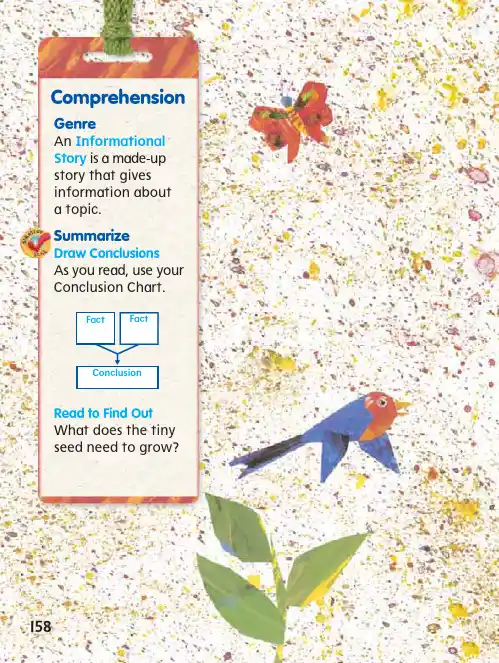
ComprehensionGenreAn InformationalStory is a made-upstory that givesinformation abouta topic.SummarizeDraw ConclusionsAs you read, use yourConclusion Chart.'BDU'BDU$PODMVTJPO158The TinyThe Tiny Seed159It is Autumn.A strong wind is blowing. It blows flower seedshigh in the air and carries them far acrossthe land. One of the seeds is tiny,smaller than any of the others.Will it be able to keep up with the others?And where are they all going?160Another seed lands on a tall and icy mountain.The ice never melts, and the seed cannot grow.The rest of the seeds fly on. But the tiny seeddoes not go as fast as the others.162163Now they fly over the ocean.One seed falls into the water and drowns.The others sail on with the wind.But the tiny seed does not go as high asthe others.164One seed drifts down onto the desert.It is hot and dry, and the seed cannot grow.Now the tiny seed is flying very low,but the wind pushes it on with the others.165Finally the wind stops and the seeds fall gentlydown on the ground. A bird comes byand eats one seed. The tiny seed is not eaten.It is so small that the bird does not see it.166Now it is Winter.After their long trip the seeds settle down.They look just as if they are going to sleepin the earth. Snow falls and covers themlike a soft white blanket. A hungry mousethat also lives in the ground eats a seedfor his lunch. But the tiny seed lies very stilland the mouse does not see it.167After a few months the snow has melted.It is really Spring! Birds fly by. The sun shines.Rain falls. The seeds grow so round and fullthey start to burst open a little. Now theyare not seeds any more. They are plants.First they send roots down into the earth.Then their little stems and leaves begin to growup toward the sun and air. There is another plantthat grows much faster than the new littleplants. It is a big fat weed. And it takes allthe sunlight and the rain away from one ofthe small new plants. And that little plant dies.168The tiny seed hasn’t begun to grow yet.It will be too late! Hurry!But finally it too starts to grow into a plant.169The warm weather also brings the childrenout to play. They too have been waitingfor the sun and spring time. One child doesn’tsee the plants as he runs along and—Oh!He breaks one! Now it cannot grow any more. 170171The tiny plant that grew from the tinyseed is growing fast, but its neighborgrows even faster. Before the tiny planthas three leaves the other plant has seven!And look! A bud! And now even a flower!172But what is happening? First there are footsteps. Then a shadow looms over them. Then a hand reaches down and breaks off the flower.A boy has picked the flower to give to a friend.173Now the tiny plant from the tiny seedis all alone. It grows on and on. It doesn’t stop.The sun shines on it and the rain waters it.It has many leaves. It grows taller and taller.It is taller than the people. It is taller thanthe trees. It is taller than the houses.And now a flower grows on it. People comefrom far and near to look at this flower.It is the tallest flower they have ever seen.It is a giant flower.174175All summer long the birds and bees andbutterflies come visiting. They have neverseen such a big and beautiful flower.176177178The days grow shorter. The nights grow cooler.And the wind carries yellow and red leavespast the flower. Some petals drop from thegiant flower and they sail along with the bright leaves over the land and down to the ground.What do you think willhappen to the flower?179The wind blows harder. The flower has lostalmost all of its petals. It sways and bends awayfrom the wind. But the wind grows strongerand shakes the flower. Once more the windshakes the flower, and this time the flower’sseed pod opens. Out come many tiny seedsthat quickly sail far away on the wind.180181。
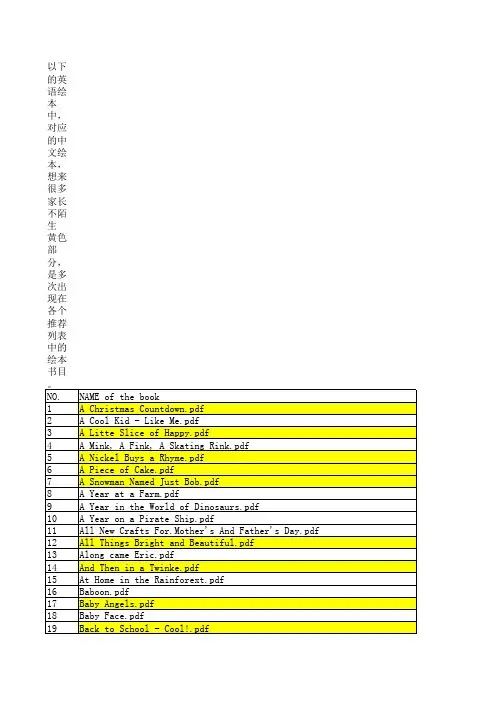
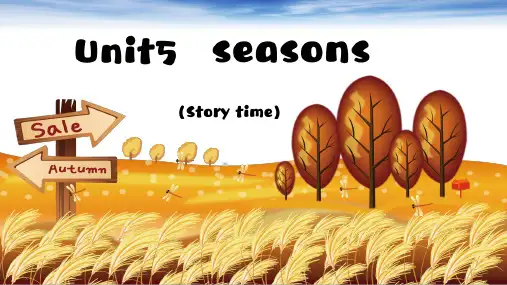
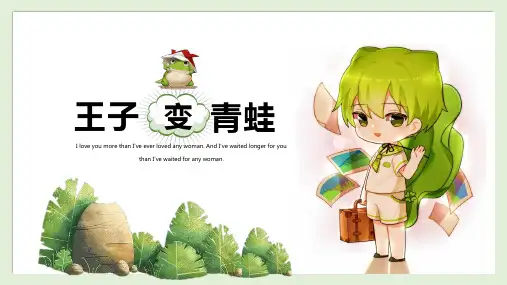
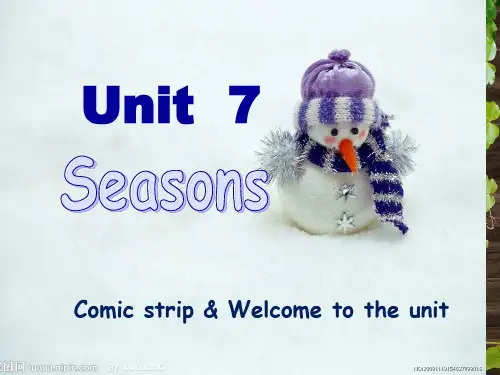
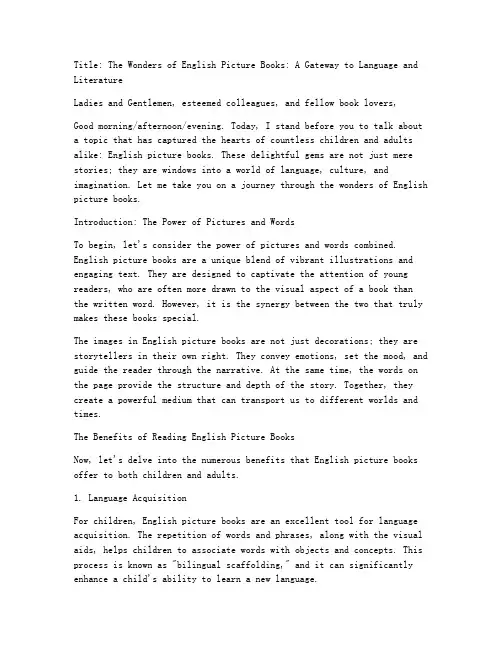
Title: The Wonders of English Picture Books: A Gateway to Language and LiteratureLadies and Gentlemen, esteemed colleagues, and fellow book lovers,Good morning/afternoon/evening. Today, I stand before you to talk about a topic that has captured the hearts of countless children and adults alike: English picture books. These delightful gems are not just mere stories; they are windows into a world of language, culture, and imagination. Let me take you on a journey through the wonders of English picture books.Introduction: The Power of Pictures and WordsTo begin, let's consider the power of pictures and words combined. English picture books are a unique blend of vibrant illustrations and engaging text. They are designed to captivate the attention of young readers, who are often more drawn to the visual aspect of a book than the written word. However, it is the synergy between the two that truly makes these books special.The images in English picture books are not just decorations; they are storytellers in their own right. They convey emotions, set the mood, and guide the reader through the narrative. At the same time, the words on the page provide the structure and depth of the story. Together, they create a powerful medium that can transport us to different worlds and times.The Benefits of Reading English Picture BooksNow, let's delve into the numerous benefits that English picture books offer to both children and adults.1. Language AcquisitionFor children, English picture books are an excellent tool for language acquisition. The repetition of words and phrases, along with the visual aids, helps children to associate words with objects and concepts. This process is known as "bilingual scaffolding," and it can significantly enhance a child's ability to learn a new language.2. Literacy SkillsReading picture books also helps to develop literacy skills such as phonemic awareness, comprehension, and fluency. Children learn to recognize letters, sound out words, and understand the meaning of the text. As they grow older, these skills will serve them well in their academic journey.3. Cultural AwarenessEnglish picture books expose readers to a wide range of cultures and perspectives. Through the stories and characters, children learn about different customs, traditions, and ways of life. This cultural awareness is crucial in today's globalized world.4. Emotional DevelopmentThe stories in picture books often explore complex emotions and themes. Children can relate to the characters and their experiences, which helps them to understand and express their own feelings. This emotional development is an essential part of a child's growth.5. Imagination and CreativityPicture books are a fertile ground for imagination and creativity. The vivid illustrations and engaging stories stimulate the imagination of young readers, allowing them to create their own versions of the story. This creative process is vital for the development of critical thinking skills.Notable English Picture BooksThroughout history, English picture books have produced many timeless classics. Here are a few notable examples:- "The Very Hungry Caterpillar" by Eric Carle – This charming book introduces young readers to the life cycle of a butterfly while teaching them numbers and days of the week.- "Where the Wild Things Are" by Maurice Sendak – This imaginative tale of a young boy's adventure in a land of mythical creatures explores themes of loneliness and freedom.- "The Gruffalo" by Julia Donaldson – A clever and amusing story about a mouse using its wits to outsmart predators, teaching children about the value of courage and cleverness.Conclusion: A World of PossibilitiesIn conclusion, English picture books are a treasure trove of language, literature, and imagination. They offer a world of possibilities for children and adults alike. By reading these books, we can learn, grow, and explore new horizons.As educators, librarians, and parents, let us continue to nurture the love of reading in our children. Let us open the pages of Englishpicture books and embark on adventures that will last a lifetime.Thank you for your attention, and I invite you to share the wonders of English picture books with the young readers in your lives.The End---This speech aims to provide a comprehensive overview of the importance and benefits of English picture books, highlighting their role in language acquisition, literacy skills, cultural awareness, emotional development, and imagination. It also touches upon some classic examples of English picture books, emphasizing their timeless appeal.。
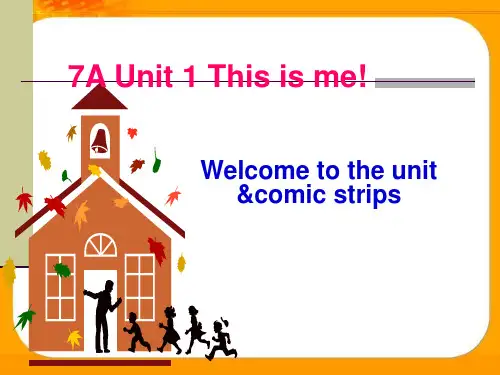
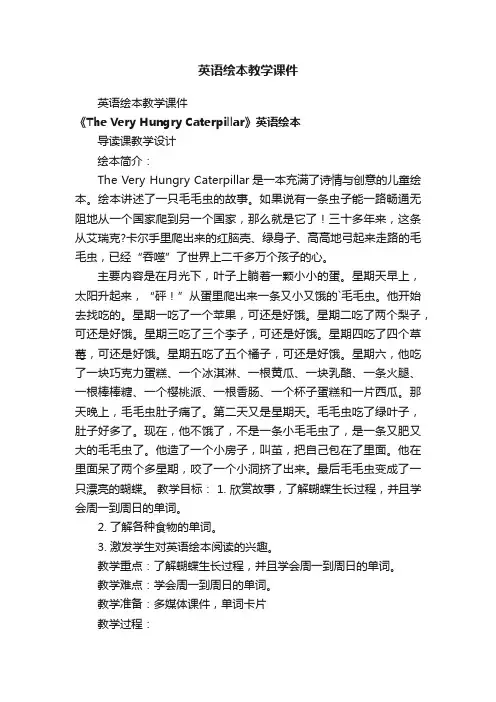
英语绘本教学课件英语绘本教学课件《The Very Hungry Caterpillar》英语绘本导读课教学设计绘本简介:The Very Hungry Caterpillar是一本充满了诗情与创意的儿童绘本。
绘本讲述了一只毛毛虫的故事。
如果说有一条虫子能一路畅通无阻地从一个国家爬到另一个国家,那么就是它了!三十多年来,这条从艾瑞克?卡尔手里爬出来的红脑壳、绿身子、高高地弓起来走路的毛毛虫,已经“吞噬”了世界上二千多万个孩子的心。
主要内容是在月光下,叶子上躺着一颗小小的蛋。
星期天早上,太阳升起来,“砰!”从蛋里爬出来一条又小又饿的`毛毛虫。
他开始去找吃的。
星期一吃了一个苹果,可还是好饿。
星期二吃了两个梨子,可还是好饿。
星期三吃了三个李子,可还是好饿。
星期四吃了四个草莓,可还是好饿。
星期五吃了五个橘子,可还是好饿。
星期六,他吃了一块巧克力蛋糕、一个冰淇淋、一根黄瓜、一块乳酪、一条火腿、一根棒棒糖、一个樱桃派、一根香肠、一个杯子蛋糕和一片西瓜。
那天晚上,毛毛虫肚子痛了。
第二天又是星期天。
毛毛虫吃了绿叶子,肚子好多了。
现在,他不饿了,不是一条小毛毛虫了,是一条又肥又大的毛毛虫了。
他造了一个小房子,叫茧,把自己包在了里面。
他在里面呆了两个多星期,咬了一个小洞挤了出来。
最后毛毛虫变成了一只漂亮的蝴蝶。
教学目标: 1. 欣赏故事,了解蝴蝶生长过程,并且学会周一到周日的单词。
2. 了解各种食物的单词。
3. 激发学生对英语绘本阅读的兴趣。
教学重点:了解蝴蝶生长过程,并且学会周一到周日的单词。
教学难点:学会周一到周日的单词。
教学准备:多媒体课件,单词卡片教学过程:Step 1 Warm up1、Greeting: What day is today? What date is today?2、Sing a song: Seven days a week.Step 2 Presentation1、故事导入Once upon a time, there was a little egg lay on a leaf in the light of the moon. It’s a summer night. It’s hot and quiet. You can hear the sound of the wind, the owl and the leaf.(出示卵的图片,让学生猜猜最后卵会变成什么?)2、讲解绘本1)One Sunday morning, cock-a-doodle-do! The warm sun came up, and POP! A caterpillar came out of the egg. It’s very tiny. It climbed, climbed and climbed from morning till night. It didn’t eat anything. It’s so hungry. It’s very hungry. It started to look for some food the next day. (此处引入Sunday的单词,并重点教授,并且教师可扮演毛毛虫做爬行动作,用肢体语言帮助学生理解climb的意思。
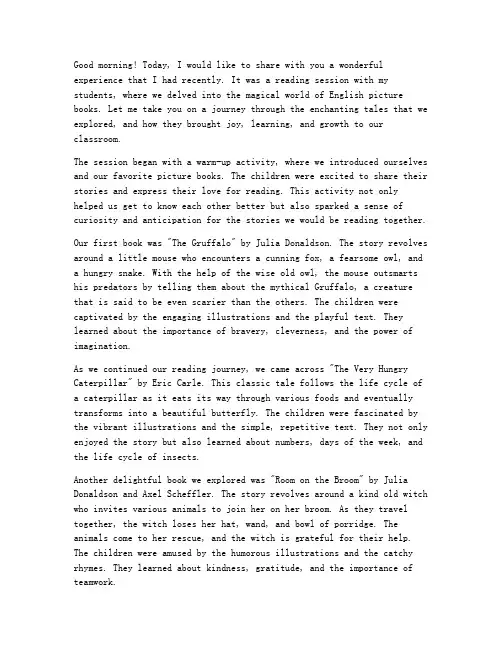
Good morning! Today, I would like to share with you a wonderful experience that I had recently. It was a reading session with my students, where we delved into the magical world of English picture books. Let me take you on a journey through the enchanting tales that we explored, and how they brought joy, learning, and growth to our classroom.The session began with a warm-up activity, where we introduced ourselves and our favorite picture books. The children were excited to share their stories and express their love for reading. This activity not only helped us get to know each other better but also sparked a sense of curiosity and anticipation for the stories we would be reading together.Our first book was "The Gruffalo" by Julia Donaldson. The story revolves around a little mouse who encounters a cunning fox, a fearsome owl, and a hungry snake. With the help of the wise old owl, the mouse outsmarts his predators by telling them about the mythical Gruffalo, a creature that is said to be even scarier than the others. The children were captivated by the engaging illustrations and the playful text. They learned about the importance of bravery, cleverness, and the power of imagination.As we continued our reading journey, we came across "The Very Hungry Caterpillar" by Eric Carle. This classic tale follows the life cycle of a caterpillar as it eats its way through various foods and eventually transforms into a beautiful butterfly. The children were fascinated by the vibrant illustrations and the simple, repetitive text. They not only enjoyed the story but also learned about numbers, days of the week, and the life cycle of insects.Another delightful book we explored was "Room on the Broom" by Julia Donaldson and Axel Scheffler. The story revolves around a kind old witch who invites various animals to join her on her broom. As they travel together, the witch loses her hat, wand, and bowl of porridge. The animals come to her rescue, and the witch is grateful for their help. The children were amused by the humorous illustrations and the catchy rhymes. They learned about kindness, gratitude, and the importance of teamwork.One of the most heartwarming stories we read was "The Snowman" by Raymond Briggs. This beautifully illustrated book tells the story of a young boy who builds a snowman and goes on an adventure with it. The story is filled with magical moments, and the children were enchanted by the snowman's ability to come to life. They learned about friendship, imagination, and the beauty of nature.As we continued our reading session, we also explored other wonderful tales such as "The Gruffalo's Child" by Julia Donaldson, "We're Going on a Bear Hunt" by Michael Rosen, and "The Fantastic Mr. Fox" by Roald Dahl. Each book brought a unique message and taught us valuable life lessons.Throughout the session, I observed the children's enthusiasm andcuriosity grow. They were not only captivated by the stories but also eager to participate in the activities that accompanied them. We engaged in discussions, acted out the stories, and even created our own illustrations. The children's imaginations were sparked, and their love for reading was nurtured.In conclusion, the English picture book reading session was a memorable experience that brought immense joy and learning to our classroom. The stories we explored not only entertained the children but also taught them valuable life lessons. They learned about courage, kindness, friendship, and the beauty of the world around them.As teachers, we have the power to ignite a passion for reading in our students. By introducing them to the magical world of English picture books, we can inspire them to explore new worlds, expand their imaginations, and develop a love for literature. Let us continue to nurture this love for reading and watch our students grow into lifelong learners.Thank you for joining me on this wonderful journey. I hope that you too will be inspired to share the magic of English picture books with the young readers in your lives.Thank you!。
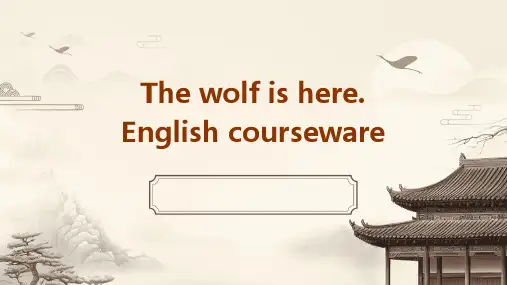
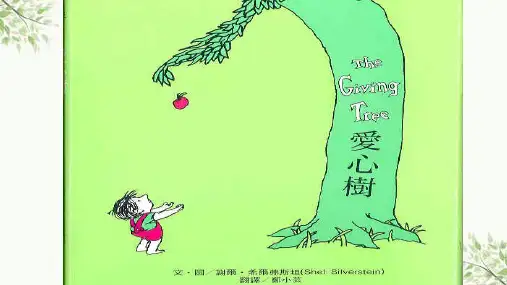
英语绘画读本100本#1: Where the Wild Things Are by Maurice Sendak (1963)#2: Goodnight Moon by Margaret Wise Brown (1947)#3: The Very Hungry Caterpillar by Eric Carle (1979)#4: The Snowy Day by Ezra Jack Keats (1962)#5: Don't Let the Pigeon Drive the Bus by Mo Willems (2003)#6: Make Way for Ducklings by Robert McCloskey (1941)#7: Harold and the Purple Crayon by Crockett Johnson (1955)#8: Madeline by Ludwig Bemelmans (1939)#9: Millions of Cats by Wanda Gag (1928)#10: Knuffle Bunny: A Cautionary Tale by Mo Willems (2004)#11: The Story of Ferdinand by Monroe Leaf, ill. Robert Lawson (1936)#12: Good Night Gorilla by Peggy Rathmann (1994)#13: Blueberries for Sal by Robert McCloskey (1948)#14: The True Story of the Three Little Pigs by Jon Scieszka, ill. Lane Smith(1989) #15: Lilly's Purple Plastic Purse by Kevin Henkes (1996)#16: Owl Moon by Jane Yolen (1987)#17: Caps for Sale by Esphyr Slobodkina (1947)#18: In the Night Kitchen by Maurice Sendak (1970)#19: Miss Rumphius by Barbara Cooney (1982)#20: George and Martha by James Marshall (1972)#21: Bark, George by Jules Feiffer (1999)#22: The Monster at the End of this Book by Jon Stone, ill. by Mike Smollin (1971) #23: Bread and Jam for Frances by Russell Hoban, illustrated by Lillian Hoban (1964)#24: Chicka Chicka Boom Boom by Bill Martin, Jr. and John Archambault, ill. Lois E hlert (1989)#25: The Little House by Virginia Lee Burton (1942)#26: Corduroy by Donald Freeman (1976)#27: The Tale of Peter Rabbit by Beatrix Potter (1902)#28: Alexander and the Terrible, Horrible, No Good, Very Bad Day by Judith Viorst, ill. Ray Cruz(1972)#29: Sylvester and the Magic Pebble by William Steig (1969)#30: Brown, Bear, Brown Bear, What do you See? by Bill Martin Jr., ill. Eric Carle (1 967)#31: No, David by David Shannon (1998)#32: Click Clack Moo, Cows That Type by Doreen Cronin, ill. by Betsy Lewin (2000)#33: Cloudy with a Chance of Meatballs by Judi and Ron Barrett (1978)#34: Olivia by Ian Falconer (2000)#35: Tikki Tikki Tembo by Arlene Mosel, ill. Blair Lent (1968)#36: Stinky Cheese Man and Other Fairly Stupid Tales by Jon Scieszka, ill. Lane Smit h (1992)#37: Eloise by Kay Thompson, ill. Hilary Knight (1955)#38: Harry the Dirty Dog by Gene Zion, ill. by Margaret Bloy Graham (1956)#39: The Napping House by Audrey and Don Wood (1984)#40: Mike Mulligan and His Steam Shovel by Virginia Lee Burton (1939)#41: The Relatives Came by Cynthia Rylant, ill. Stephen Gammell (1985)#42: Curious George by H.A. Rey (1941)#43: Tuesday by David Wiesner (1991)#44: Strega Nona by Tomie de Paola (1975)#45: The Polar Express by Chris Van Allsburg (1985)#46: Scaredy Squirrel by Melanie Watt (2006)#47: If You Give a Mouse a Cookie by Laura Numeroff (1985)#48: The Big Orange Splot, by Daniel Pinkwater (1977)#49: King Bidgood is in the Bathtub by Audrey Wood, ill. Don Wood (1985)#50: Black and White by David Macaulay (1990)#51: Jumanji by Chris Van Allsburg (1981)#52: Miss Nelson is Missing by Harry Allard, ill. James Marshall (1977)#53: The Snowman by Raymond Briggs (1978)#54: The Three Pigs by David Wiesner (2001)#55: The Little Engine That Could by Watty Piper, ill. George & Doris Hauman (196 1)#56: Frederick by Leo Lionni (1967)#57: Diary of a Worm by Doreen Cronin, ill. Harry Bliss (2003)#58: Flotsam by David Wiesner (2006)#59: Why Mosquitoes Buzz in People's Ears (1975) by Verna Aardema, ill.Leo and D iane Dillon (1975)#60: Chicken Soup With Rice: A Book of Months by Maurice Sendak (1962)#61: Lost and Found by Oliver Jeffers (2005)#62: The Story About Ping by Marjorie Flack (1933)#63: Traction Man is Here!, by Mini Grey (2005)#64: “I Can't,” Said the Ant: A Second Book of Nonsense by Polly Cameron (1961) #65: Skippyjon Jones by Judy Schachner (2003)#66: Officer Buckle and Gloria by Peggy Rathmann (1995)#67: Little Blue and Little Yellow by Leo Lionni (1959)#68: The Arrival by Shaun Tan (2006)#69: We're Going on a Bear Hunt by Michael Rosen, ill. Helen Oxenbury (1989)#70: Miss Fanshawe and the Great Dragon Adventure by Sue Scullard (1986)#71: The Paper Bag Princess by Robert Munsch, ill by Michael Martchenko (1980) #72: The Little Brute Family by Russell Hoban, ill. Lilian Hoban (1966)#73: The Story of Babar, the Little Elephant (1933) by Jean de Brunhoff#74: Runaway Bunny by Margaret Wise Brown (1942)#75: Horton Hatches the Egg by Dr. Seuss (1940)#76: Zoom at Sea by Tim Wynne-Jones, ill. Eric Beddows (1983)#77: The Library by Sarah Stewart, ill. David Small (1995)#78: How the Grinch Stole Christmas by Dr. Seuss#79: Our Animal Friends at Maple Hill Farm, by Alice and Martin Provensen (1974) #80: The Jolly Postman: or, Other People's Letters by Janet Ahlberg (1986)#81: Possum Magic by Mem Fox, ill. Julie Vivas (1983)#82: Who Needs Donuts? by Mark Alan Stamaty (1973)#83: The Lorax by Dr. Seuss (1971)#84: Chester's Way by Kevin Henkes (1988)#85: Whistle for Willie by Ezra Jack Keats (1964)#86: Yoko by Rosemary Wells (1998)#87: Kitten's First Full Moon by Kevin Henkes (2004)#88: Stellaluna by Janell Cannon (1993)#89: A Hole is to Dig: A First Book of First Definitions by Ruth Krauss, ill. Maurice Sendak (1952)#90: Not a Box by Antoinette Portis (2006)#91: Dinosaur Bob and His Adventures With the Family Lazardo by William Joyce (1 988)#92: Swimmy by Leo Lionni (1963)#93: The Giving Tree by Shel Silverstein (1964)#94: The Little Mouse, the Red Ripe Strawberry, and the Big Hungry Bear by Audrey and Don Wood (1984)#95: The Gardener by Sarah Stewart, ill. David Small (1997)#96: The Very Quiet Cricket by Eric Carle (1990)#97: Where Is the Green Sheep? by Mem Fox, ill. Judy Horacek (2004)#98: Anatole by Eve Titus (1956)#99: Little Pea by Amy Krause Rosenthal, ill. by Jen Corace (2005)#100: Go Away, Big Green Monster by Ed Emberley (1992)#101: More, More, More Said the Baby: Three Love Stories by Vera B. Williams。
英语绘本饥饿的毛毛虫教学计划Lesson Plan for The Very Hungry Caterpillar.Objectives:To improve students' reading and listening comprehension skills.To enhance their vocabulary and language skills.To provide an opportunity for students to explore the concepts of hunger, growth, and transformation.Materials:A copy of The Very Hungry Caterpillar by Eric Carle.Whiteboard or chart paper.Markers or crayons.Food props (optional)。
Procedure:Pre-Reading Activities:Introduce the book by showing the cover and reading the title.Ask students to look at the cover and make predictions about what the book might be about.Lead a discussion on the concept of hunger. What does it feel like to be hungry? How do people typically satisfy their hunger?Reading Activities:Read the book aloud to students, pausing to ask comprehension questions and discuss key vocabulary words.Have students follow along in their own copies of the book.Encourage students to point out the different fruits and foods that the caterpillar eats.Discuss the caterpillar's growth and transformation throughout the story. What changes do they notice?Post-Reading Activities:Review the main events of the story.Ask students to recall the different foods that the caterpillar ate.Lead a discussion on the significance of the metamorphosis the caterpillar undergoes. What does it symbolize?Have students create their own illustrations of the caterpillar's transformation.As an optional activity, provide food props related to the story and have students act out the different stages of the caterpillar's journey.Assessment:Observe students' participation and comprehension during the pre-, during-, and post-reading activities.Collect students' illustrations or writing assignments as evidence of their understanding of the story.Extension Activities:Have students research different types of caterpillars and their life cycles.Lead a science experiment on plant growth and the role of caterpillars in pollination.Explore other books by Eric Carle that focus on natureand metamorphosis.Differentiation:For struggling readers, provide additional support during the reading activities by reading aloud and pausing to explain unfamiliar words.For advanced readers, challenge them to identify literary devices such as similes and metaphors used in the story.中文回答:教学计划,饥饿的毛毛虫。
英语阅读计划绘本图片English Reading Plan for Picture Books.Introduction.Reading picture books, especially in English, is a wonderful way to introduce young learners to the joys of literature while simultaneously enhancing their language skills. These books, often brightly illustrated and filled with engaging stories, provide an ideal platform for early reading comprehension and vocabulary building. Here's a comprehensive reading plan designed to help young readers progress through a range of picture books, gradually increasing the complexity of the content and language used.Week 1: Starting with the Basics.Begin with picture books that feature simple language and familiar themes. These books often have a limited vocabulary and sentence structure, making them accessibleto beginning readers. Example titles include "The Very Hungry Caterpillar" by Eric Carle and "Brown Bear, Brown Bear, What Do You See?" by Bill Martin Jr. and Eric Carle. Encourage children to read aloud, pointing to the words and following the illustrations for added comprehension.Week 2: Introducing New Vocabulary.Move on to picture books that introduce a few new vocabulary words and slightly more complex sentence structures. Titles like "The Giving Tree" by Shel Silverstein and "The Rainbow Fish" by Marcus Pfister are excellent choices for this stage. Encourage children to identify new words and discuss their meanings, helping them to understand how these words fit into the story.Week 3: Enhancing Comprehension.Increase the complexity of the stories by selecting picture books with more detailed plots and characters. Books like "Where the Wild Things Are" by Maurice Sendak and "The Lorax" by Dr. Seuss provide richer narratives andencourage deeper understanding of the story's themes and messages. Encourage children to retell the story in their own words, asking questions to prompt further discussion and critical thinking.Week 4: Expanding the Reading Horizons.By the fourth week, children should be ready to tackle more challenging picture books with a wider range of vocabulary and more sophisticated language. Titles such as "The Tiger Who Came to Tea" by Judith Kerr and "The Snowy Day" by Ezra Jack Keats offer beautiful illustrations and engaging stories that will engage young readers for hours. Encourage them to make connections between the story and their own experiences, discussing feelings and ideas evoked by the narrative.Ongoing Activities.As children progress through the reading plan, it's important to supplement their reading with additional activities that enhance language learning. Consider thefollowing activities to supplement your child's reading time:Vocabulary Building: Play word games like "I Spy" or "Go Fish" to introduce new vocabulary words and practice their use in context.Storytelling: Encourage children to create their own stories based on the themes and characters they've encountered in their reading. This helps them to develop their own narrative skills and imagination.Role-Playing: Use picture books as a starting pointfor role-playing games, allowing children to act out scenes from the story and bring the characters to life.Art Projects: Encourage children to create their own illustrations based on the stories they've read. This helps them to develop their fine motor skills and visual comprehension.Conclusion.By following this reading plan and incorporating additional language-learning activities, young readers will gradually develop their reading comprehension, vocabulary, and narrative skills. The journey through the world of picture books is not only fun but also incrediblybeneficial for their overall development. With patience and encouragement, children will discover the joy of reading and the power of language in stories that captivate their imaginations.。